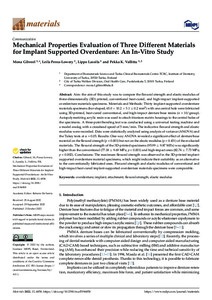Mechanical Properties Evaluation of Three Different Materials for Implant Supported Overdenture: An In-Vitro Study
Gibreel Mona; Perea-Lowery Leila; Lassila Lippo; Vallittu Pekka K
https://urn.fi/URN:NBN:fi-fe2022112968033
Tiivistelmä
Aim:
the aim of this study was to compare the flexural strength and elastic modulus of three-dimensionally (3D) printed, conventional heat-cured, and high-impact implant-supported overdenture materials specimens.
Materials and Methods:
Thirty implant-supported overdenture materials specimens (bar-shaped, 65.0 x 10.2 x 5.1 +/- 0.2 mm(3)) with one central hole were fabricated using 3D-printed, heat-cured conventional, and high-impact denture base resins (n = 10/group). Autopolymerizing acrylic resin was used to attach titanium matrix housings to the central holes of the specimens. A three-point bending test was conducted using a universal testing machine and a model analog with a crosshead speed of 5 mm/min. The indicative flexural strength and elastic modulus were recorded. Data were statistically analyzed using analysis of variance (ANOVA) and the Tukey tests at alpha = 0.05.
Results:
One-way ANOVA revealed a significant effect of denture base material on the flexural strength (p < 0.001) but not on the elastic modulus (p = 0.451) of the evaluated materials. The flexural strength of the 3D-printed specimens (95.99 +/- 9.87 MPa) was significantly higher than the conventional (77.18 +/- 9.69 MPa; p < 0.001) and high-impact ones (82.74 +/- 7.73 MPa; p = 0.002).
Conclusions:
The maximum flexural strength was observed in the 3D-printed implant-supported overdenture material specimens, which might indicate their suitability as an alternative to the conventionally fabricated ones. Flexural strength and elastic modulus of conventional and high-impact heat-cured implant-supported overdenture materials specimens were comparable.
Kokoelmat
- Rinnakkaistallenteet [27094]
